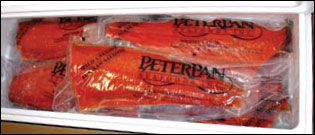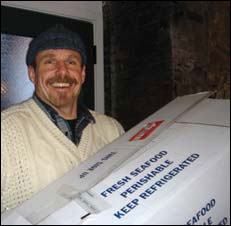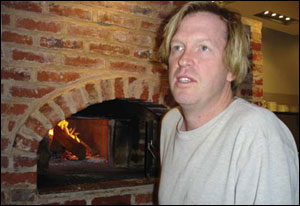By Jessica Smits

Woodberry Kitchen won't open its doors for another two hours, but for Chef Spike Gjerde the pressure is on. There are vegetables to prep, the day's menu to finalize, and his forty pounds of Alaskan sockeye salmon is still on its way.
Cast iron machinery perched along towering walls of exposed brick alludes to the restaurant's former industrial identity as the old Clipper Mill, a foundry on the outskirts of Baltimore's Hampden neighborhood. Now the airy space marks the newest venture for Chef Gjerde, a fixture in the Baltimore restaurant scene for over a decade. Gjerde, his wife Amy, and sommelier Nelson Carey opened Woodberry Kitchen in October 2007 with more on the agenda than just fine dining.
The restaurant specializes in cuisine made from local and sustainable ingredients. "We made a decision that these are things that matter to us," Gjerde says.
From the wine list to the house-made cheese to, especially, the seafood, the local and sustainable mantra informs all aspects of the business, he says. "The Chesapeake Bay is the most glaring reason to pursue business in this way." Disease and overharvesting have decimated wild oyster populations. Pollution threatens the health of the water and species like blue crabs and striped bass. "If you are at all aware of what's happening, you have to start thinking about your impact."
But the forthcoming sockeye salmon isn't exactly local. It hails from the pristine waters of Bristol Bay, Alaska — a long way from the Chesapeake. Sourcing only local sustainable seafood would be difficult, Gjerde says, and he wouldn't want to put that much pressure on an already struggling Bay. It's a balancing act — the less local the product, the more sustainable it has to be, he explains. "The Alaska fisheries are one of the great models of sustainability in the world." For Gjerde, this fact trumps the more than 3,500-mile distance.
Gjerde relies on his primary seafood supplier, Gaylord Clark, owner of Two Oceans Seafoods, for information on sustainability. The two met through the Chesapeake Sustainable Business Alliance, an organization that encourages businesses to reduce their environmental impact and support the local economy. "I can't tell you how frustrating it is to talk to old-line seafood guys who can't give me a straight answer on where the fish comes from," let alone its environmental impact, Gjerde says. Gaylord Clark embodies a newer trend.
A self-proclaimed talker and a commercial fisherman himself, Clark is well versed in the nuances of sustainable seafood. He delivers not only fish to local chefs, but also information. He discusses things like harvesting methods, management structures, and stock assessments — probably more than the chefs ever wanted to know, he jokes. Most chefs circulate among their clientele during the evening, he says. By educating the chef, Clark equips the chef to, in turn, educate the customers. The customers may then tell friends or go to a seafood market and ask specifically for sustainable seafood. Public interest is key, he says, because that is what ultimately moves politicians to action.
And local customers, he says, are becoming more interested in the source of their food. It's broader than the niche market it used to be, Clark says. "People are paying more attention to where their food is coming from — partly because of cost, partly because of education, and partly because of palate."
Baltimore was a steak and potatoes kind of town, Clark says, when he was growing up in the 1960s and 1970s in its Roland Park neighborhood. Sustainability, agriculture methods, and the sourcing of food, weren't yet part of the demand equation. After fishing for six years out of Cape May, New Jersey, and a stint on a freezer trawler out of New Bedford, Massachusetts, Clark moved to the West Coast where he spent the next 20 years shuttling freight to Russia and fishing for species from sole to salmon. Given the opportunity to return to his native Maryland and live in a remodeled barn on his family's Carriage House Farm in Baltimore County, Clark, his wife, and daughters were excited to make the move.
|
Flown in overnight from Bristol Bay, Alaska, sockeye salmon (top of the page) will soon take its place alongside local vegetables and meats on tonight's menu board (above). Chef Spike Gjerde (right) unloads the salmon before it's whisked away for preparation. Photographs by Jessica Smits.
|
Upon his return, Clark and his family, including his parents who also live on the 82-acre farm, decided to capitalize on the increasing attention paid to local agricultural products. They raise free-range chickens and turkeys and sell the farm-fresh eggs and meat to local individuals and restaurants.
Clark's seafood sourcing business, Two Oceans Seafoods, reflects his other identity as a commercial fisherman — an identity he reclaims each summer when he returns to Alaska to fish for salmon aboard his boat the Jack of Hearts.
Clark started his business when he saw the scarcity of West Coast seafood in East Coast markets. His company's name is a nod to Clark's sourcing from both the Atlantic and Pacific oceans. Its focus on only sustainable seafood just makes sense, he says. "It's a self-defeating proposition to fish the last fish in the sea." And for his business to survive he must count on seafood's availability in the future. "If I lose my product because it's not sustainable, then I'm going to lose my customers."
Squeezed among shelves of flour and vegetables, and refrigerators full of milk and meats, Spike Gjerde sits at his computer fine-tuning a description of Roasted Beet Borscht for tonight's menu. Gaylord Clark appears in the doorway holding the delivery Gjerde's been waiting for. Dressed in a knit cap and a cabled wool fisherman's sweater, Clark plops the box on the floor and extends a hearty handshake and greeting to the shaggy-haired blonde chef.

Delivery in tow, Gaylord Clark of Two Oceans Seafoods heads straight to the kitchen to meet Chef Gjerde. There's a place and face for everything served at the restaurant, says Gjerde. Clark is the face of sustainable seafood. Photographs by Jessica Smits.
|
Without delay, Clark rips open the box to display a mound of individually packaged bright pink salmon fillets. The sockeye were caught the previous summer and then frozen and packaged by Peter Pan Seafoods near Bristol Bay. There's no need to lecture on this fishery — Gjerde's heard it all before and knows that it's considered one of the most sustainable in the world. He looks it over discerningly — almost as if he might not approve — but then says enthusiastically, "Right-o, when can I get more?"
"Next week is the earliest," Clark replies, as Gjerde quickly unloads the salmon into plastic bins, which kitchen workers whisk off without any direction or discussion. With perishable fish on the line, Clark's not willing to risk the common mishaps associated with an overnight delivery from Alaska on the weekend. "But I can get you red drum out of Texas. It's farmed raised."
"Farmed? What's the environmental impact of that?" Gjerde asks.
Clark says the farm looks good — it uses natural seagrass habitat, and feeds the fish vegetable matter, rather than fishmeal (the use of wild fish to feed farmed fish is an oft-cited argument against certain aquaculture operations, particularly farmed Atlantic salmon).
Before Clark has even finished explaining, Gjerde is already clicking on the drum farm's listing on Google to see for himself. Clark explains that he's trying to broaden his base by providing fish like the farmed red drum. He's having trouble procuring local sustainable seafood. The striped bass season has been touch and go. For over two weeks bad weather has thwarted his contacts fishing for stripers at Coltons Point near the mouth of the Potomac. The wind has been blowing, scattering the fish and kicking up a heavy chop for the small vessels.
"So you can think about it," Clark tells Gjerde, referring to the red drum. "No rush."

Keeping the wood fires burning, Chef Spike Gjerde gets ready for the dinner rush at Woodberry Kitchen. The restaurant aims to balance sustainability with the celebrated traditions and ingredients of the Chesapeake region. Photographs by Jessica Smits.
|
"It's a rush for me, man," Gjerde retorts. He has menus to plan.
Gjerde's not entirely happy with what he's seen on the red drum fish farm's website and he turns down Clark's offer. Their wording is too careful, he says. He thinks there may be more than meets the eye. And going back to his balance scale — if it's not local, it has to be extra sustainable.
Just then, a representative from an aquaculture operation that does meet with Gjerde's approval walks into the cramped office. Scott Fritze from Marvesta looks young enough to be the delivery guy, but he's co-owner of the shrimp-farming business on Maryland's Eastern Shore that has garnered significant attention in the press (see Bringing It All Back Home).
Fritze hands Gjerde a bag filled with shrimp harvested just this morning in his Hurlock, Maryland facility — by tonight they'll be in Gjerde's seafood stew. They've solved a lot of the problems associated with shrimp farming, Gjerde says. Their facility is completely enclosed, no pollution, 90 percent vegetable feed, and non-medicated, he explains. To Gjerde, Marvesta represents the new face of Chesapeake seafood. He's embraced Chesapeake Bay aquaculture in his restaurant. In addition to the farmed shrimp, he offers five types of cultured oysters — Stingrays, Rappahannocks, Snow Hills, and Olde Salts grown by Rappahannock River Oysters, LLC; and Choptank Sweets grown by Marinetics. Putting oysters into the water is a win for the Chesapeake Bay, he says.
And it helps his goal of balancing the importance of Chesapeake traditions with "what it means to take things out of the Bay."
"The Bay's hanging in the balance," Gjerde says. "The effort that's going to be required to change things is monumental. It goes way beyond watermen and biologists."
And in the meantime, he sees the effects on the restaurant industry. People read about poor water quality, they hear about things like Pfiesteria, he says. "I think most chefs have given up on the idea of Chesapeake Bay seafood because it doesn't connote the level of quality that it once did."
The state of the Chesapeake gives Clark pause as well. He wonders about the status of blue crabs and if he'll decide to offer them this year. If he doesn't, what will replace them in his repertoire? With the Bay "on the ropes," he says, "you can't count on the seafood remaining sustainable." For Clark this means looking beyond the Bay to keep his company afloat.
But despite his close connection to the salmon country of the North Pacific, Clark remembers that it all began for him in the Atlantic, fishing for scallops and flounder out of Cape May. He's committed to providing sustainable seafood from the Chesapeake, he says. "But if the Bay goes down the tubes, where do I look for my next fish?"
Seafood deliveries complete, Gjerde moves to the main dining room where he adds logs to the orange glow of the growing fire in the restaurant's wood-burning oven. Later, he'll cook the salmon in the oven and then serve it with lentils, leek flan, and a miniature green salad. Local greens are hard to come by in the dead of winter, so the salad will be made up of whatever he can get his hands on. Sustainability takes sacrifice, he says. "We're asking a lot from our customers to follow us on this road, but I think it's worth it."
![[Maryland Sea Grant]](/GIFs/h_footer_mdsg.gif)